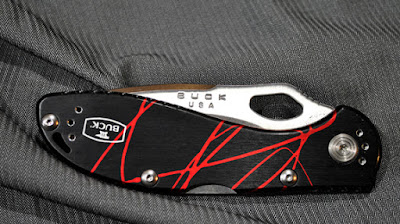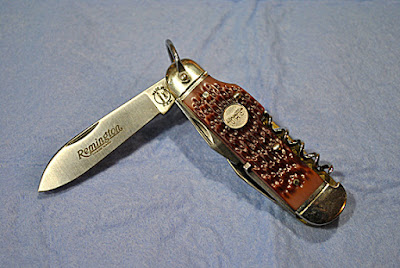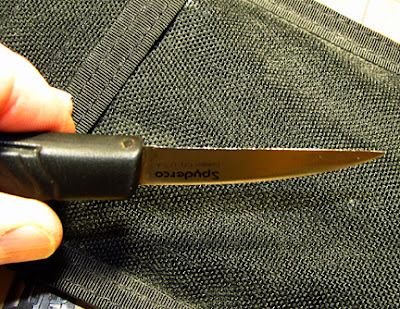 |
| It's a funny looking knife, but it inspired the designers of other wallet hide-out knives. |
I recently came across a Spydercard( C01). They were very popular and people still collect
them partially because of their scarcity, partially for the story associated
with the knife designer.
First the knife.
The Spydercard is the size of a credit card and 0.2 inch
thick. That’s about the thickness of 4
credit cards. Designed to slip into your
pocket or wallet, this 3.4 inch long knife opens to exposé a 2.4 in cutting
edge. The handle lock, like that used on
the Square Head, secures the blade in the open position as well as the closed
position.
The AUS6 steel it is made from, was at the time, an entry
level steel. To keep costs down and
provide reasonable performance, many knife manufacturers used AUS6. This steel is comparable to 440A with a
little extra kick. The kick is vanadium. This element forms tiny particles of vanadium
carbide at the steel’s grain boundaries increasing hardness and edge
retention. The 14% chromium not only
forms carbides but also forms an important transparent thin film of chromium
oxide that protects the steel from oxidation or staining better known as rust.
Spydercard’s most popular blade configuration, as I remember
it when I sold them, was the partially serrated. On a small blade, especially with a hard-to-hold
handle, increased cutting performance is critical. This isn’t the sort of knife you pack for hiking
the northwest Cascades, but you might pack it if you thought you might have to
cut something to escape.
 |
| That's my wallet, a little over stuffed for my taste, but I could lose a few cards and squeeze that knife in. |
The Designer
I wasn’t able to find much about the designer, Eduard
Bradichansky. He is described as a Russian
Jew who immigrated to Israel, I assume, to escape the repressive Russian government. He has been described as a gunsmith and
jeweler who later worked with Spyderco designing what became known as the Spydercard
and the Shabaria (C59). He was apparently
killed in a Hamas attack so brutal that identification was made based on dental
records and the presence of Spydercard and Shabaria prototypes. Sounds mysterious doesn’t it?
Well, I’m not going to ask Spyderco what really happened and
wasn’t it just too convenient he had the prototypes on him. I’m not into conspiracies. I’ve always found that any conspiracy
involving more than two people breaks down over time.
 |
| A little better look at the Spydercard's serrations |
You know what they say, two can keep a secret especially if
one of them is dead.
















